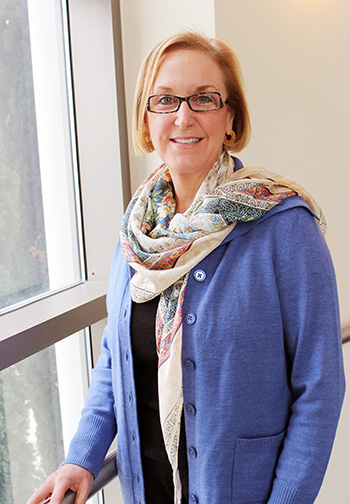 Lisa Barr has been treating patients with pain issues for nearly 30 years, but she doesn’t call herself a pain management physician. “The phrase pain management implies that you can’t treat the problem, so you have to manage it,” she says. “Einstein says you can’t solve problems with the same thinking that created them. I strive to evolve the way I look at these problems.”
Lisa Barr has been treating patients with pain issues for nearly 30 years, but she doesn’t call herself a pain management physician. “The phrase pain management implies that you can’t treat the problem, so you have to manage it,” she says. “Einstein says you can’t solve problems with the same thinking that created them. I strive to evolve the way I look at these problems.”
A native of Hampton Roads, Dr. Barr graduated from Eastern Virginia Medical School, where she was Chief Resident in Physical Medicine and Rehabilitation. She founded APM Spine and Sports Physicians in 1990, where she and her partners focus on treating, not managing, chronic and acute pain problems. “By constantly refining our procedural skills, leveraging technology and looking for unique, innovative ways to treat the cause,” she explains, “we’re able to expand and integrate our skills into effective healing strategies.”
Her passionate belief in the body’s innate ability to heal itself is at the heart of her approach to treating patients. “I started out with a keen interest in the mind-body connection,” she says, “I believe real healing that addresses the whole person is the future of medicine.”
“Listening to each patient’s unique story and looking with a keen eye at the mechanism of injury and extrapolating their compensatory strategies is part of the fun and part of the challenge,” Dr. Barr says. “Every patient with a lower extremity issue has to walk and run, if possible, in the hall. I want to see how their bodies move and adapt. This exercise, as well as a very hands-on assessment of their joint mechanics, soft tissue reactions and neural processing, often reveals the core issue that cannot be revealed by static x-rays or MRI scans.”
Dr. Barr likens the body to “a flesh-covered computer with potential hardware and software issues. Being humans, we also have the overlay of feelings and emotions which must be taken into account in any effective therapeutic doctor-patient relationship,” she emphasizes. “Intervening early is the key to a successful outcome as we minimize dysfunctional behavioral patterns and abnormal kinetic forces that can eventually lead to irreparable changes.”
From traditional spinal interventions like epidural steroid injections and facet therapies to the newer biologic therapies such as PRP and prolotherapy, Dr. Barr focuses on optimizing how the body functions and moves. “Treating pain is very rewarding when you can focus on the source and return people to productive lifestyles without dependence on medication,” she says.
What used to be considered alternative treatment is now considered biologic. In 1992, Dr. Barr became the first physician in Virginia to offer prolotherapy to patients with sports injuries, arthritis and other injuries. “We inject a solution of sugar water with Xylocaine and fish oil into the ligament or tendon where it attaches to the bone,” she explains. “The sugar water acts as an osmotic pressure gradient, while the Xylocaine blocks pain receptors. The fish oil acts as a chemotactic agent. The injection causes localized inflammation, which increases blood supply and the flow of nutrients into the affected area and removes debris.” In other words, “the injection stimulates the body to heal itself.”
In an era of biologic treatment, Dr. Barr says, patients are now using their own cells to help repair injured tissue, rather than relying on an artificial substance. About 10 years ago, she introduced the newer PRP injection therapy to Hampton Roads. PRP is produced using the patient’s own blood, by concentrating healing growth factors, normal proteins found in blood. After concentrating the blood in a special centrifuge, Dr. Barr extracts the Platelet Rich Plasma and injects it under x-ray or ultrasound guidance. She is supported by no less than New York’s prestigious Hospital for Special Surgery: in a study reported in the February 2013 Clinical Journal of Sports Medicine, researchers found that PRP treatment improved pain and function, and in 73 percent of patients, appeared to delay the progression of osteoarthritis of the knee, compared with hyaluronic acid, a common injection treatment. PRP was found to be superior to HA at each time point, with sustained improvement at the final six-month follow-up.
For Dr. Barr, leveraging the technology means merging the science and the art in an individualized approach for each patient. She knows her approach has been called unorthodox, but “I do what works for my patients,” she says. “If an appropriate tool is available, we’re going to offer it to our patients” – whether a standard treatment or innovative procedures like prolotherapy, PRP or any of the many healing modalities she studies. She’s experienced in interventional pain, skilled in osteopathic manipulation, a licensed acupuncturist, a yogi and a Reiki master.
She insists that her patients understand their diagnoses, how she intends to treat them and importantly, what’s required of them. “While I recognize not everyone I treat is a pro athlete, I enjoy working with motivated patients who don’t want to give their power away to pills, machines or doctors,” she states plainly, “patients who want to engage in a process of change and transformation in their body.”
In addition to her practice, she’s a consultant for ProGolf Health, a group of clinicians who provide holistic health care for professional golfers worldwide, and she’d like to start a golf medicine clinic here in Hampton Roads. She’s also working on a screenplay, and a book about holistic healing and the mind-body connection.

